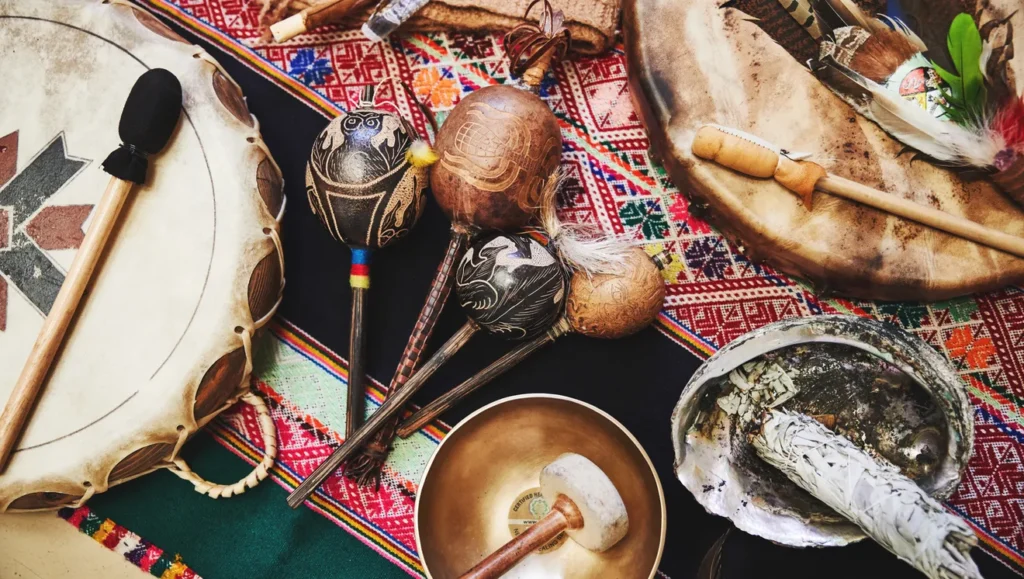
Healing rituals have been an integral part of human history, deeply embedded in our cultural and spiritual identities. In this exploration of the transformative power of these practices, we delve into their origins, significance, and potential to offer emotional, spiritual, and physical healing in our modern lives.
Table of Contents
Healing Rituals in a Nut Shell
Healing rituals are various practices used to restore balance and harmony to the mind, body, and spirit. These rituals can take many forms, ranging from meditative practices, physical exercises, to traditional ceremonies. While the manifestation of these rituals may vary greatly, their core purpose remains the same: to facilitate healing and promote well-being.
The Worldwide Expanse of Healing Rituals
Each culture and community around the globe has a unique approach to wellness and healing, passed down through generations. These practices not only provide a sense of connection to our ancestral roots but also offer a wealth of inspiration for our wellness routines.
Embracing Ikebana in Japan
In Japan, a traditional art form known as Ikebana has been used as a meditative practice since the 15th century. Ikebana, or the art of flower arranging, inspires a sense of inner peace and healing as each flower is carefully arranged in a symbolic harmony.
Ayurveda: The Ancient Indian Wisdom
Considered one of the oldest healing practices in the world, Ayurveda is a traditional approach to medicine from India. It focuses on balancing the three doshas, namely Vata, Pitta, and Kapha, through targeted treatments such as exercise, nutrition, massage, and meditation.
Shamanic Healing in Peru
In the Andes Mountains’ lofty heights, the Q’ero shamans have practiced ancient healing rituals for thousands of years. Leveraging the power of natural elements like plants and crystals, they cleanse and rejuvenate the energy in the body.
Apache Burden Baskets: A Native American Practice
In North America, the Apache tribe has a unique ritual of weaving small burden baskets. Representations of their worries are deposited in these baskets, symbolizing the release of their cares to the universe.
Lomilomi: The Hawaiian Touch
In Hawaii, an ancient healing ritual known as Lomilomi is practiced. This technique involves long, gentle strokes on the body, accompanied by prayers and chanting, promoting physical and spiritual healing.
Releasing Souls in Thailand
In Thailand, a Buddhist healing ritual involves releasing animals into the wild, signifying the liberation of souls and promoting healing.
Rolling Jade in China
Jade rollers, used on the face and neck, have been part of wellness routines in China since the 17th century. They are believed to increase circulation and brighten the skin.
Healing Rituals in a Modern Context
While these traditional practices have centuries-old roots, their relevance in our modern world is not diminished. As we navigate the challenges of modern living, the significance of these healing rituals is amplified.
Mindfulness through Body Scan Meditation
The Body Scan Meditation, an MBSR meditation practice, helps attend to the arising sensations in the body. By focusing on the present moment, it encourages relaxation and self-awareness.
The Healing Power of Aromatic Baths
Bathing with essential oils or aromatic bath salts can help release stress. The ancient practice of soaking in aromatic waters shifts the thinking mind to the sensory experience, promoting relaxation and tranquility.
Smudging Herbs and Incense
Using smudging herbs and incense can cleanse your environment, setting up a creative ritual for contemplating the healing threshold you wish to cross.
Creative Expression
Unleashing your creativity through art can be a powerful healing ritual. It provides an outlet for the subconscious to express itself, promoting self-discovery and emotional release.
Nature Rituals
Engaging with nature, whether through walks, gardening, or simply observing, can have profound healing effects. It allows for a deeper connection with the natural world, promoting a sense of peace and balance.
Sound Exploration
Music, dance, and sound meditations can have powerful healing effects on the body and emotions. They provide an outlet for stress and promote a sense of joy and freedom.
Journaling
Journaling can be a powerful healing ritual. Externalizing your thoughts onto paper promotes self-awareness and provides a cathartic release.
Self-compassion
Practicing self-compassion can be instrumental in the healing process. It encourages acceptance and understanding, fostering a sense of self-love and inner peace.
Channels of Hope in Healing Rituals
Healing rituals often involve an element of hope, a vital emotion for life. Regardless of where you are in your journey, hope can be a powerful catalyst for healing. According to Dr. Anthony Scioli’s hope scale, there are four distinct channels for hope:
- The Mastery Channel: This channel focuses on a sense of control and clearly defined goals.
- The Attachment Channel: This channel emphasizes the importance of connection and trust with others.
- The Survival Channel: This channel encourages learning, growth, and courage.
- The Spiritual Channel: This channel promotes a sense of meaning and faith.
Whether we engage in traditional cultural rituals or adopt modern practices, the power of healing rituals cannot be denied. They offer us a path to self-discovery, inner peace, and holistic wellness. By embracing these practices, we can navigate the complexities of life with greater resilience, positivity, and hope.
Here are some more questions and answers about healing rituals:
What are healing rituals?
Healing rituals are practices, often steeped in cultural or spiritual traditions, that aim to promote physical, emotional, and spiritual wellness.
What is a ritual healer?
A ritual healer is an individual who facilitates healing through the performance of specific ceremonies or rituals.
What is the power of ritual in healing?
Rituals in healing can provide a sense of comfort, control, and connection. They can help individuals process emotions, release stress, and promote a sense of balance and wellbeing.
What are the 4 types of rituals?
The four types of rituals typically include rites of passage, healing rituals, seasonal or cyclical rituals, and personal rituals.
What are the 7 steps of healing?
The seven steps of healing often include recognition, acknowledgment, acceptance, release, transformation, forgiveness, and gratitude.
What are examples of healers?
Examples of healers can include traditional medicine practitioners, Reiki healers, shamans, energy healers, and holistic health practitioners.
Why are rituals powerful?
Rituals are powerful because they provide a sense of structure, meaning, and continuity in our lives. They can help us process emotions, connect with our spiritual beliefs, and foster a sense of community and belonging.
How to do a spiritual ritual?
Performing a spiritual ritual often involves setting an intention, creating a sacred space, and engaging in practices that promote connection with the spiritual realm. This could include meditation, prayer, chanting, or the use of sacred objects.
